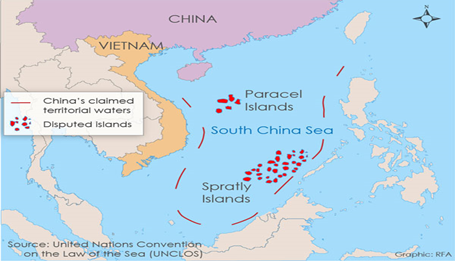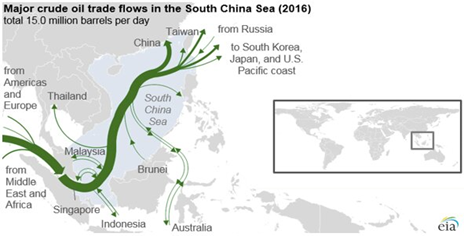

26th October 2022 (8 Topics)
Context
Recently, the Chinese government said it has “overlapping claims” with Vietnam over maritime rights in parts of the East Sea, Indonesia showed concerns and rejected China’s offer for any negotiations and said that Jakarta’s economic interests are threatened by China’s Nine-Dash Line.
About
- China currently claims ‘indisputable sovereignty over the South China Sea.
- These nine-dash lines are not geographical boundaries but are interpreted by China to advance its claims.
- The line runs as far as 2,000km from the Chinese mainland to within a few hundred kilometers of the Philippines, Malaysia, and Vietnam.
|
Countries' maritime Borders in the South China Sea:
- Several countries bordering the South China Sea; are
- Peninsular Malaysia,
- Thailand (via the Gulf of Thailand),
- Philippines
- Singapore,
- East Malaysia
- Brunei, and
- Indonesia
- Vietnam,
- China,
- Brunei, and
- Taiwan

Why it is a significant location?
The South China Sea is a contested maritime area that is subject to claims of partial possession by five countries currently, namely the Philippines, Vietnam, China, Brunei, Taiwan, and Malaysia, which has remained unresolved for decades.
However, there is an interest in their claims:
- For China: China claims most of the contested sea, reaching almost to the Philippines shores, and has built artificial islands with heavy military developments on them which worry the neighboring nations and it rejects the UN-backed international tribunal ruling as well.
- The nine-dash line asserted by China violates the principle of Exclusive Economic Zones (EEZ).
|
Exclusive Economic Zones (EEZ)
|
- For Other Island Countries: The stalled negotiations between China and ASEAN made headway on the Code of Conduct as four of the ASEAN nations also made territorial claims on the disputed waters which adds to the problem with the already non-negotiable behavior of China.
- The 9-dash line makes China exclusive rights to marine resources of the region and hence affects the economy of developing island countries like Indonesia.
- For India: The South China Sea holds the major Oil trade route for countries in the Pacific and India affects if the economy of these counties gets impacted.



